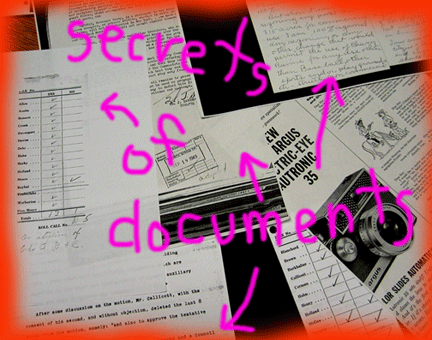Can a group of enterprising South LA 15-year-olds (and a couple 16-year-olds) knit together a hidden part of LA history and, in so doing, teach Los Angeles a little more about itself?
That’s what a class-full of 9th graders at Animo Film and Theater Academy are attempting to do. Animo FTA is a charter school located among LAUSD’s most troubled high schools. The history the Animo kids are examining is that of Dodger stadium. But the project is a bit different than what you might think.
The story about how a tight-knit Mexican American community located in the hills of Chavez Ravine came to be yanked apart, and its houses demolished—the land eventually sold for a song to Walter O’Malley—has been immortalized in the form of a stage play by Culture Clash, a Ry Cooder music CD and a PBS special.
But, what few people seem to remember is that when Dodger owner O’Malley came to California in 1957 with the idea of relocating the his then Brooklyn-based ball club to Los Angeles, he originally considered housing the team, not in Chavez Ravine but at Wrigley Field, an art deco style stadium located on 160 acres in South Los Angeles. Wrigley was then the home of the Angels (but a different Angels than our present day Angels). O’Malley purchased both the Angels and their field in order to get a SoCal toe hold. Eventually, however, he decided he preferred the 300 acres of Chavez Ravine.
*******************************************************************************************************************
Located in South LA a half mile from USC, Animo FTA routinely outperforms other public high schools schools in its area, including LAUSD’s nearest magnet school. (On the last released California Standardized Tests, FTA scored 701, Jefferson High school, 457, Santee High, 486, Manual Arts High, 513, and Orthopedic Medical Magnet 691.) Yet FTA draws from the same student pool as Jefferson and Santee.
FTA was founded in 2004 (and in an earlier incarnation in 1996) by former screen writer, Steve Bachrach, as a school within a school on the campus of troubled Jefferson High School. The idea was that a different teaching model, some creative approaches to classwork, and more personal attention for students, would help kids learn better. In 2005, when FTA’s test scores had jumped 50 points in less than a full year of existence, rather than try to replicate the model, LAUSD administrators instead threatened repeatedly to kill it.
“The way it works in this district,” former School Board Member David Tokofsky told me when I asked about LAUSD’s seemingly illogical behavior toward FTA. “The nail that sticks up is perceived as an inconvenience, and it gets hammered down. If that same nail sticks up in a more provocative way, like Steve Bachrach has, it’s in danger of being yanked out altogether and tossed away.”
After Bachrach grew tired of battling the district for his school, he yanked FTA away from LAUSD and accepted Steve Barr’s offer to bring it under the Green Dot umbrella as a charter.
I first ran across Steve and FTA when I was reporting on the race riots that took place at Jefferson in the spring of 2005 and have been following their progress ever since.
********************************************************************************************************************
The students’ Dodgers research was triggered when some other Animo FTA kids ran across the information about O’Malley and Wrigley while researching something unrelated. This, in turn, gave school principal Bachrach an idea that he proposed to some of his 9th graders who were in search of a class project: What if, asked Bachrach, they researched a sort of Tale of Two Los Angeles Neighborhoods and looked at what might have happened if the Dodgers had stayed at Wrigley? How might South LA be different if it was still home to a baseball team? And, what was the role of local and state government—for good and for ill—in influencing and facilitating that decision?
In order to find the answers to these and other questions, the students have been tracking down the oldest residents—or former residents—of both neighborhoods in an effort to construct an oral history. They’re also talking to city planners, historians, trolling through newspaper archives and public records, and a plethora of other sources.

On Monday, at Bachrach’s request, I drove to the FTA campus, located in a converted office building at the corner of 38th Street and Broadway, to chat with some these earnestly researching FTA kids. Bachrach thought I could give his students a few tips on reporting and interviewing.
We talked for around 90 minutes at the end of which time I got a lot more information from these smart kids, than I ever gave.
For example, I learned:
*One of O’Malley’s biggest reputed phobias when it came to Wrigley Field was the whore house located across the street.
*While the Los Angeles Times was stumping heartily for the Dodgers/Chavez Ravine project, some local media of the time—most notably KFWB radio—took the side of the original Chavez Ravine residents.
*The original Los Angeles Police Academy that is located near Dodger stadium, predated the stadium, so was silent witness to the drama that took place there. But despite the Academy’s location, it was LA County sheriff’s deputies, not LAPD officers who forcibly evicted the residents of Chavez Ravine in order to make way for the development that the city had in mind.
*Chavez Ravine was originally cleared so that some Richard Neutra-designed public housing projects could be built in Chavez Ravine. But during the Red Scare of the 1950’s, public housing was suddenly viewed as some kind of Communist plot. So fearful public officials who originally championed Elysian Fields, as the public housing complex was to be called, now dropped it as if it was scalding hot, making way for O’Malley’s low-ball offer on the 300 acres.
And a lot more. “We learn one thing and it leads us to something else that we need to find out,” said a pretty long-haired girl named Ivory.
“The thing is,” said Bachrach, “kids can learn about concepts like Eminent Domain, racial housing estate covenants, and McCarthyism from a textbook it’s just something boring they have to memorize. But when they learn those same concepts in a real life context, they really come alive.”
Eventually, the FTA 9th graders want to present what they’ve learned as a gallery installation—using words and visuals—in some interesting public place, like LA City Hall.
I’ll let you know when it happens.
*******************************************************************************************************************
PHOTO: Front row: Jasmine Washington, Lisbeth Villasenor, Elizabeth Cabrera, Cedric Moore II. Back row: Andrea Linan, Michael Gonzalez, Ivory Negrete.


I saw the PBS special on Chavez Ravine and thought it very interesting. It will be difficult, if not impossible, for the students to prepare an accuate study or model on “what would have happened.” The biggest pitfall will be letting their own prejudices get in the way of an objective study. Besides that, there are just too many complexities and variables that they can never complete factor in.
If the students want to take the study further, from the past to the future, then they should analyze the impact that the Supreme Court decision in “KELO et al. v. CITY OF NEW LONDON et al” has on people who want to stay in their homes but are forced out in favor of private developers.
That decision was flawed, a disgrace, and a slap in the face to private property rights. See: John McCain Condemns Kelo Decision.
Cool kids doing cool research. Good on ’em!
If you’re interested in the architectural side of things with Neutra and Chavez Ravine, UCLA emeritus professor Thomas S. Hines wrote an article on it in a 1982 issue of the Journal of Urban History titled “Housing, Baseball, and Creeping Socialism: the Battle of Chavez Ravine, Los Angeles”. It tells the bigger story of the Dodgers, but it goes in depth into Neutra’s plans for the housing development. Unfortunately, it’s not online (unless you have access to JStor).
He wrote a book on Neutra as well, though I’m not sure if the Chavez Ravine plans are in there.
Evan beat me to it as the Chavez Revine story goes back to the early fifties when John Entenza was promoting the “Case Study Houses” and Neutra had that apartment development. All scuttled by cries of “Socialism.” Interested history that you don’t get in schools.
Culture Clash brought up the Neutra plan in their play Chavez Ravine.
Here’s something from Peter Dreier and Jan Breidenbach on Frank Wilkinson and public housing.
http://www.nhi.org/online/issues/145/wilkinson.html